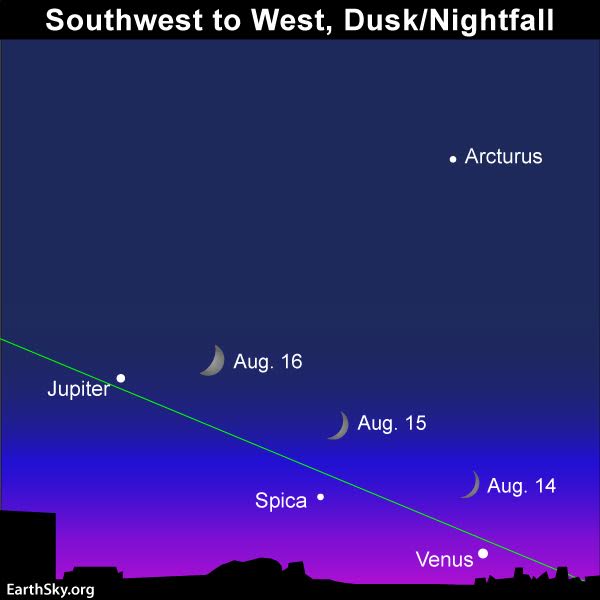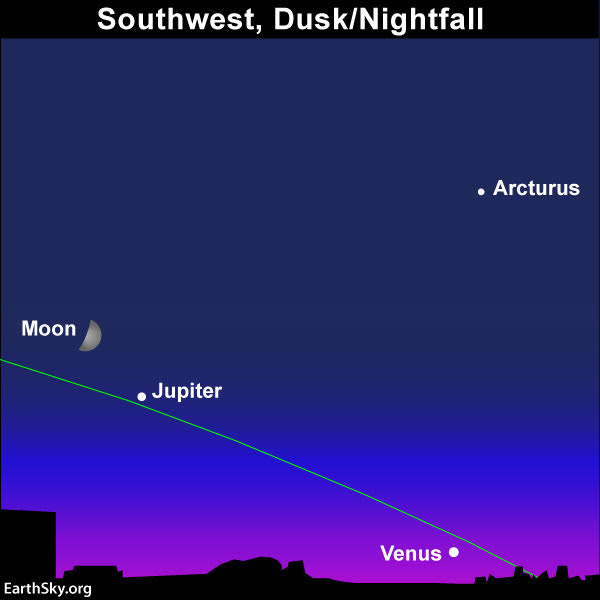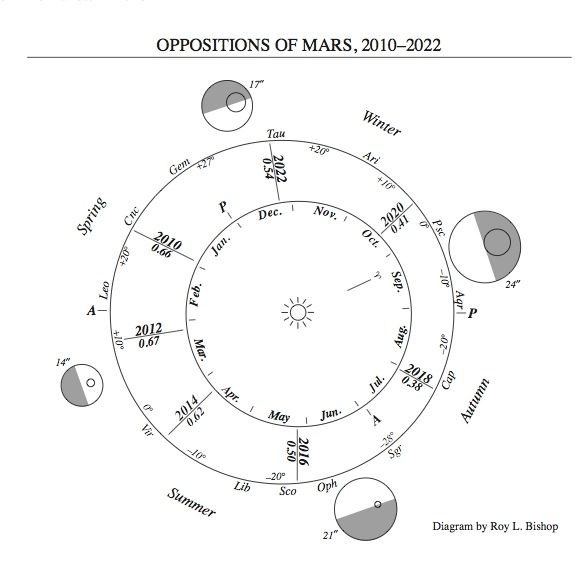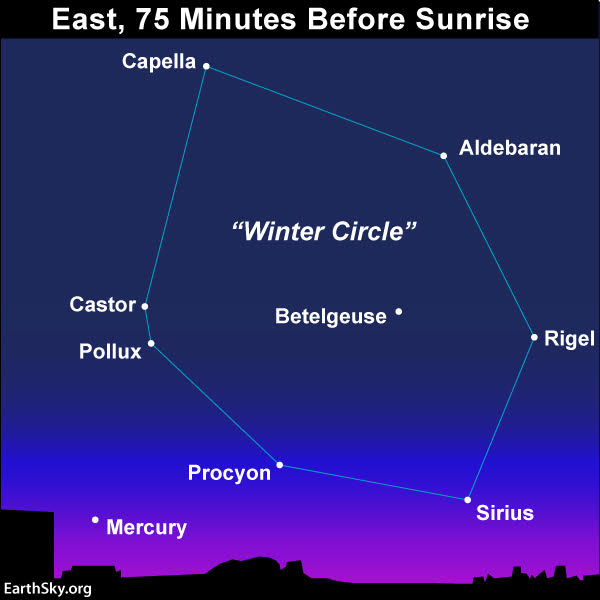

You can catch Venus and Jupiter – 2 very bright planets – in the western half of sky at nightfall throughout August, 2018. Be sure to catch ’em around mid-August, when the moon sweeps near. Read more.
Click the name of a planet to learn more about its visibility in July 2018: Venus, Jupiter, Saturn, Mars and Mercury
Venus is the brightest planet, and it’s very prominent this month in the west after sunset. Throughout August, Venus appears as a dazzling evening “star.” Look for Venus to adorn the western evening sky until October 2018.
At mid-northern latitudes, Venus attained its highest altitude as the evening “star” in June 2018. That’s in spite of the fact that Venus’ greatest elongation (maximum angular distance from the setting sun) won’t occur until August 17, 2018. At mid-northern latitudes, Venus sets roughly 2 hours after the sun in early August. By the month’s end, that’ll taper to about 1 1/2 hours after sunset.
In the Southern Hemisphere, Venus climbs highest up in the evening sky in August. At temperate latitudes in the Southern Hemisphere (South Africa, southern Australia), Venus sets about 3 1/2 hours after sunset throughout the month.
Circle August 14, 15 and 16 on your calendar. That’s when the young moon will be sweeping past Venus (and Jupiter) in the evening sky. The western twilight will make the pairing all the more picturesque.

In 2018, Jupiter acts as your guide to the constellation Libra. Raul Cortes in Monterrey, Mexico, created this image from a photo he took on June 4, 2018.
Jupiter remains bright and beautiful throughout August 2018. Our planet Earth passed between the sun and Jupiter – bringing the planet to opposition – on the night of May 8-9, 2018. In the Northern Hemisphere, you’ll find Jupiter highest up for the night around dusk or nightfall, appearing a bit west (right) of due south; in the Southern Hemisphere, you’ll see Jupiter nearly overhead at dusk. Jupiter is brighter than any star, but it’s not brighter than Venus, which beams mightily in the west after sunset.
Although Jupiter is usually the 4th-brightest celestial object to light up the heavens, after the sun, moon and Venus, Mars actually supersedes Jupiter as the 4th-brightest celestial object all month long in August 2018.
Jupiter shines in front of the constellation Libra the Scales until November 2018. Look for Libra’s brightest stars near Jupiter, Zubenelgenubi and Zubeneschamali (both star names are pronounced with the same rhythm as Obi-Wan Kenobi, of “Star Wars”).
If you aim binoculars at Zubenelgenubi, you’ll see this star as two stars. Zubeneschamali, meanwhile, is said to appear green in color, although, astronomers say, stars can’t look green.
Let the moon guide your eye to Jupiter on the evenings of August 16 and August 17.

On August 17, 2018, the moon shines close to Jupiter, on the same date that Venus reaches its greatest elongation. Read more.
Saturn and Mars adorn the eastern half of the sky at dusk and nightfall. During the first few weeks of August, Saturn transits – reaches its high point for the night – at about the same time that Venus sets (roughly 9 p.m. local time or 10 p.m. local daylight saving time). Then Mars transits some two hours after Saturn does.
Near the month’s end, Saturn will transit at roughly 8 p.m. local time (9 p.m. local daylight saving time), and throughout the month, Mars will transit about two hours after Saturn does.
Click here for a recommended sky almanac providing you with the transit times for the planets.
Middle to late evening offers a better view of Saturn and Mars, as these worlds are seen higher up in the sky than they are at nightfall.
You can tell Mars from Saturn because Mars has a reddish color and Saturn looks golden. Binoculars show their colors better than the eye alone.
Watch for the moon to pair up with Saturn on or near August 20 and with Mars on or near August 23.

Watch for the moon to go by Saturn and journey toward Mars from August 20 to 22. Read more.
At present, both Saturn and Mars shine more brilliantly than a 1st-magnitude star. However, Mars is brighter than Saturn. Saturn’s brilliance peaked at its June 27 opposition, and Mars’ brilliance came to a head at its July 27 opposition.
It’s not often that Mars outshines Jupiter, normally the fourth-brightest celestial object to light up the sky, after the sun, moon and Venus. But, for a couple of months in 2018, Mars will outshine Jupiter from about July 7 to September 7, 2018.
Both Mars and Saturn are slowly dimming throughout the month. Because Mars is dimming at a faster rate than Saturn is, Mars will be about 15 times brighter than Saturn at the beginning of the month, and some 10 times brighter by the month’s end.
Remember Mars’ historically close opposition of August 28, 2003? That year, it was closer and brighter than it had been in some 60,000 years. The July opposition was the best since 2003, and what’s more, Mars will remain bright and beautiful all through August 2018!
Read more: Mars brighter in 2018 than since 2003
Click here for more about close and far Mars oppositions

Diagram by Roy L. Bishop. Copyright Royal Astronomical Society of Canada. Used with permission. Visit the RASC estore to purchase the Observer’s Handbook, a necessary tool for all skywatchers. Read more about this image.
Mercury, the innermost planet of the solar system, moves out of the evening sky and into the morning sky on August 9, 2018. Mercury probably won’t first become visible in the morning sky until August 20th or so. The last week of August and the first several days of September will provide a good view of Mercury for the Northern Hemisphere and the southern tropics. Mercury will be harder to spot from temperate latitudes in the Southern Hemisphere.
During the last week of August at mid-northern latitudes, Mercury will rise about 1 1/2 hours before sunrise. At temperate latitudes in the Southern Hemisphere, on the other hand, Mercury only rises an hour or less before the sun. Click here for a recommended almanac telling you when the sun and Mercury rise into your sky.
Mercury will reach its greatest elongation from the sun on August 26, 2018, and its reign as the morning “star” will extend until September 21, 2018 (same date that Venus reaches its greatest illuminated extent in the evening sky).

Familiar with the Winter Circle? It’ll help you to locate Mercury, the innermost planet, in the morning sky. Read more.
What do we mean by bright planet? By bright planet, we mean any solar system planet that is easily visible without an optical aid and that has been watched by our ancestors since time immemorial. In their outward order from the sun, the five bright planets are Mercury, Venus, Mars, Jupiter and Saturn. These planets actually do appear bright in our sky. They are typically as bright as – or brighter than – the brightest stars. Plus, these relatively nearby worlds tend to shine with a steadier light than the distant, twinkling stars. You can spot them, and come to know them as faithful friends, if you try.
Bottom line: In August 2018, four planets arc across the sky at dusk and nightfall. Venus lights up the western sky, with Jupiter shining above Venus, whereas Mars lords the southeast sky, with Saturn shining above Mars. Mercury becomes a morning “star” by the last week of August. Click here for recommended almanacs; they can help you know when the planets rise, transit and set in your sky.
Help EarthSky keep going! Please donate what you can to our annual crowd-funding campaign.
Don’t miss anything. Subscribe to EarthSky News by email
Get your EarthSky 2018 lunar calendar now, while they last.
Visit EarthSky’s Best Places to Stargaze, and recommend a place we can all enjoy.
from EarthSky https://ift.tt/IJfHCr


You can catch Venus and Jupiter – 2 very bright planets – in the western half of sky at nightfall throughout August, 2018. Be sure to catch ’em around mid-August, when the moon sweeps near. Read more.
Click the name of a planet to learn more about its visibility in July 2018: Venus, Jupiter, Saturn, Mars and Mercury
Venus is the brightest planet, and it’s very prominent this month in the west after sunset. Throughout August, Venus appears as a dazzling evening “star.” Look for Venus to adorn the western evening sky until October 2018.
At mid-northern latitudes, Venus attained its highest altitude as the evening “star” in June 2018. That’s in spite of the fact that Venus’ greatest elongation (maximum angular distance from the setting sun) won’t occur until August 17, 2018. At mid-northern latitudes, Venus sets roughly 2 hours after the sun in early August. By the month’s end, that’ll taper to about 1 1/2 hours after sunset.
In the Southern Hemisphere, Venus climbs highest up in the evening sky in August. At temperate latitudes in the Southern Hemisphere (South Africa, southern Australia), Venus sets about 3 1/2 hours after sunset throughout the month.
Circle August 14, 15 and 16 on your calendar. That’s when the young moon will be sweeping past Venus (and Jupiter) in the evening sky. The western twilight will make the pairing all the more picturesque.

In 2018, Jupiter acts as your guide to the constellation Libra. Raul Cortes in Monterrey, Mexico, created this image from a photo he took on June 4, 2018.
Jupiter remains bright and beautiful throughout August 2018. Our planet Earth passed between the sun and Jupiter – bringing the planet to opposition – on the night of May 8-9, 2018. In the Northern Hemisphere, you’ll find Jupiter highest up for the night around dusk or nightfall, appearing a bit west (right) of due south; in the Southern Hemisphere, you’ll see Jupiter nearly overhead at dusk. Jupiter is brighter than any star, but it’s not brighter than Venus, which beams mightily in the west after sunset.
Although Jupiter is usually the 4th-brightest celestial object to light up the heavens, after the sun, moon and Venus, Mars actually supersedes Jupiter as the 4th-brightest celestial object all month long in August 2018.
Jupiter shines in front of the constellation Libra the Scales until November 2018. Look for Libra’s brightest stars near Jupiter, Zubenelgenubi and Zubeneschamali (both star names are pronounced with the same rhythm as Obi-Wan Kenobi, of “Star Wars”).
If you aim binoculars at Zubenelgenubi, you’ll see this star as two stars. Zubeneschamali, meanwhile, is said to appear green in color, although, astronomers say, stars can’t look green.
Let the moon guide your eye to Jupiter on the evenings of August 16 and August 17.

On August 17, 2018, the moon shines close to Jupiter, on the same date that Venus reaches its greatest elongation. Read more.
Saturn and Mars adorn the eastern half of the sky at dusk and nightfall. During the first few weeks of August, Saturn transits – reaches its high point for the night – at about the same time that Venus sets (roughly 9 p.m. local time or 10 p.m. local daylight saving time). Then Mars transits some two hours after Saturn does.
Near the month’s end, Saturn will transit at roughly 8 p.m. local time (9 p.m. local daylight saving time), and throughout the month, Mars will transit about two hours after Saturn does.
Click here for a recommended sky almanac providing you with the transit times for the planets.
Middle to late evening offers a better view of Saturn and Mars, as these worlds are seen higher up in the sky than they are at nightfall.
You can tell Mars from Saturn because Mars has a reddish color and Saturn looks golden. Binoculars show their colors better than the eye alone.
Watch for the moon to pair up with Saturn on or near August 20 and with Mars on or near August 23.

Watch for the moon to go by Saturn and journey toward Mars from August 20 to 22. Read more.
At present, both Saturn and Mars shine more brilliantly than a 1st-magnitude star. However, Mars is brighter than Saturn. Saturn’s brilliance peaked at its June 27 opposition, and Mars’ brilliance came to a head at its July 27 opposition.
It’s not often that Mars outshines Jupiter, normally the fourth-brightest celestial object to light up the sky, after the sun, moon and Venus. But, for a couple of months in 2018, Mars will outshine Jupiter from about July 7 to September 7, 2018.
Both Mars and Saturn are slowly dimming throughout the month. Because Mars is dimming at a faster rate than Saturn is, Mars will be about 15 times brighter than Saturn at the beginning of the month, and some 10 times brighter by the month’s end.
Remember Mars’ historically close opposition of August 28, 2003? That year, it was closer and brighter than it had been in some 60,000 years. The July opposition was the best since 2003, and what’s more, Mars will remain bright and beautiful all through August 2018!
Read more: Mars brighter in 2018 than since 2003
Click here for more about close and far Mars oppositions

Diagram by Roy L. Bishop. Copyright Royal Astronomical Society of Canada. Used with permission. Visit the RASC estore to purchase the Observer’s Handbook, a necessary tool for all skywatchers. Read more about this image.
Mercury, the innermost planet of the solar system, moves out of the evening sky and into the morning sky on August 9, 2018. Mercury probably won’t first become visible in the morning sky until August 20th or so. The last week of August and the first several days of September will provide a good view of Mercury for the Northern Hemisphere and the southern tropics. Mercury will be harder to spot from temperate latitudes in the Southern Hemisphere.
During the last week of August at mid-northern latitudes, Mercury will rise about 1 1/2 hours before sunrise. At temperate latitudes in the Southern Hemisphere, on the other hand, Mercury only rises an hour or less before the sun. Click here for a recommended almanac telling you when the sun and Mercury rise into your sky.
Mercury will reach its greatest elongation from the sun on August 26, 2018, and its reign as the morning “star” will extend until September 21, 2018 (same date that Venus reaches its greatest illuminated extent in the evening sky).

Familiar with the Winter Circle? It’ll help you to locate Mercury, the innermost planet, in the morning sky. Read more.
What do we mean by bright planet? By bright planet, we mean any solar system planet that is easily visible without an optical aid and that has been watched by our ancestors since time immemorial. In their outward order from the sun, the five bright planets are Mercury, Venus, Mars, Jupiter and Saturn. These planets actually do appear bright in our sky. They are typically as bright as – or brighter than – the brightest stars. Plus, these relatively nearby worlds tend to shine with a steadier light than the distant, twinkling stars. You can spot them, and come to know them as faithful friends, if you try.
Bottom line: In August 2018, four planets arc across the sky at dusk and nightfall. Venus lights up the western sky, with Jupiter shining above Venus, whereas Mars lords the southeast sky, with Saturn shining above Mars. Mercury becomes a morning “star” by the last week of August. Click here for recommended almanacs; they can help you know when the planets rise, transit and set in your sky.
Help EarthSky keep going! Please donate what you can to our annual crowd-funding campaign.
Don’t miss anything. Subscribe to EarthSky News by email
Get your EarthSky 2018 lunar calendar now, while they last.
Visit EarthSky’s Best Places to Stargaze, and recommend a place we can all enjoy.
from EarthSky https://ift.tt/IJfHCr

Aucun commentaire:
Enregistrer un commentaire